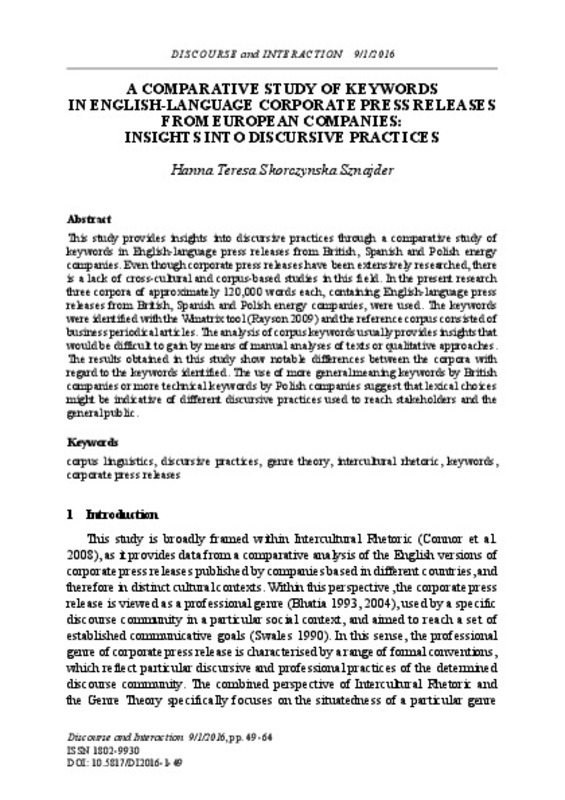Bell, A. (1991) The Language of News Media. Oxford: Blackwell.
Bhatia, V. (1993) Analysing Genre: Language Use in Professional Settings. Harlow:Longman.
Bhatia, V. (2004) Worlds of Written Discourse. London: Continuum.
[+]
Bell, A. (1991) The Language of News Media. Oxford: Blackwell.
Bhatia, V. (1993) Analysing Genre: Language Use in Professional Settings. Harlow:Longman.
Bhatia, V. (2004) Worlds of Written Discourse. London: Continuum.
Boxer, D. (2002) ‘Discourse issues in cross-cultural pragmatics.’ Annual Review ofApplied Linguistics 22, 150-167. https://doi.org/10.1017/S0267190502000089
Catenaccio, P. (2007) ‘Constructing identities in the fashion industry: Building brand andcustomer image through press releases.’ In: Garzone, G. and Ilie, C. (eds) The Use ofEnglish in Institutional and Business Settings. An Intercultural Perspective. Berlin:Peter Lang. 31-56.
Catenaccio, P. (2008) ‘Press releases as a hybrid genre: Addressing the informative/promotional conundrum.’ Pragmatics 18(1), 9-31. https://doi.org/10.1075/prag.18.1.02cat
Connor, U., Nagelhout, E. and Rozycki, W. V. (eds) (2008) Contrastive Rhetoric. Reachingto Intercultural Rhetoric. Amsterdam and Philadelphia: John Benjamins.
Handford, M. (2012) ‘Professional communication and corpus linguistics.’ In: Hyland,K., Huat, C. M. and Handford, M. (eds) Corpus Applications in Applied Linguistics.London and New York: Continuum International Publishing Group. 13-29.
Hofstede, G. and Hofstede, G. J. (2005) Cultures and Organizations: The Software of the Mind. 2nd ed. New York: McGraw Hill.
Hofstede, G., Hofstede, G. J. and Minkov, M. (2010) Cultures and Organizations:Software of the Mind: Intercultural Cooperation and its Importance for Survival. 3rded. New York: McGraw-Hill.
Jacobs, G. (1998) ‘Projected discourse: An analysis of receiver roles in press releases.’Text 18, 505-523. https://doi.org/10.1515/text.1.1998.18.4.505
Jacobs, G. (1999a) Preformulating the News: An Analysis of the Metapragmatics of PressReleases. Amsterdam: John Benjamins.
Jacobs, G. (1999b) ‘Self-reference in press releases.’ Journal of Pragmatics 31, 219-242. https://doi.org/10.1016/S0378-2166(98)00077-0
Jacobs, G. (2014) ‘Press releases.’ In: Schneider, K. and Barron, A. (eds) Pragmatics ofDiscourse. Berlin: Mouton de Gruyter. 583-599.
Kaasa, A., Vadi, M. and Varblane, U. (2013) ‘European Social Survey as a source of newcultural dimensions estimates for regions.’ International Journal of Cross CulturalManagement 13(2), 137-157. https://doi.org/10.1177/1470595813485379
Kolman, L., Noorderhaven, N. G., Hofestede, G. and Dienes, E. (2003) ‘Cross-culturaldifferences in Central Europe.’ Journal of Managerial Psychology 18(1), 76-88. https://doi.org/10.1108/02683940310459600
Lassen, I. (2006) ‘Is the press release a genre? A study of form and content.’ DiscourseStudies 8(4), 503-530. https://doi.org/10.1177/1461445606061875
McLaren-Hankin, Y. (2008) ‘“We expect to report on significant progress in our productpipeline in the coming year”: Hedging forward-looking statements in corporate pressreleases.’ Discourse Studies 10, 635-654. https://doi.org/10.1177/1461445608094216
McLaren, Y. and Gurău, C. (2005) ‘Characterising the genre of the corporate pressrelease.’ LSP & Professional Communication 4(1), 10-30.
Pander Maat, H. (2007) ‘How promotional language in press releases is dealt with byjournalists.’ Journal of Business Communication 44(1), 59-95. https://doi.org/10.1177/0021943606295780
Rayson, P. (2008) ‘From key words to key semantic domains.’ International Journal ofCorpus Linguistics 13(4), 519-549. https://doi.org/10.1075/ijcl.13.4.06ray
Rayson, P. (2009) Wmatrix: A web-based corpus processing environment, ComputingDepartment, Lancaster University [online]. http://ucrel.lancs.ac.uk/wmatrix/15 January 2015.
Sagiv, L. and Schwartz, S. H. (2007) ‘Cultural values in organisations: Insights forEurope.’ European Journal of International Management 1(3), 176-190.
Scott, M. (1997) ‘PC analysis of key words – and key key words.’ System 25(2), 233-245.Scott, M. and Tribble, C. (2006) Textual Patterns: Key Words and Corpus Analysis inLanguage Education. Amsterdam: John Benjamins. https://doi.org/10.1016/S0346-251X(97)00011-0
Strobbe, I. and Jacobs, G. (2005). E-releases: A view from linguistic pragmatics. PublicRelations Review, 31(2), 289-291. https://doi.org/10.1016/j.pubrev.2005.02.009
Stubbs, M. (2010) ‘Three concepts of keywords.’ In: Bondi, M. and Scott, M. (eds)Keyness in Texts. Amsterdam: John Benjamins. 21-42.
Swales, J. M. (1990) Genre Analysis. English in Academic and Research Settings.Cambridge: Cambridge University Press.
United Nations Statistics Division (2013) ‘Composition of macrogeographical(continental) regions.’ Standard Country and Area Codes Classifi cations (revised 31October 2013). From unstats.un.org. Online document 8 January 2015.
Wierzbicka, A. (2003) Cross-Cultural Pragmatics. The Semantics of Human Interaction.Berlin: Walter de Gruyter.
Yates, J. and Orlikowski, W. J. (1992) ‘Genres of organizational communication:A structurational approach to studying communication and media.’ Academy ofManagement Review 17(2), 299-326.
[-]









